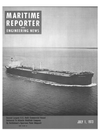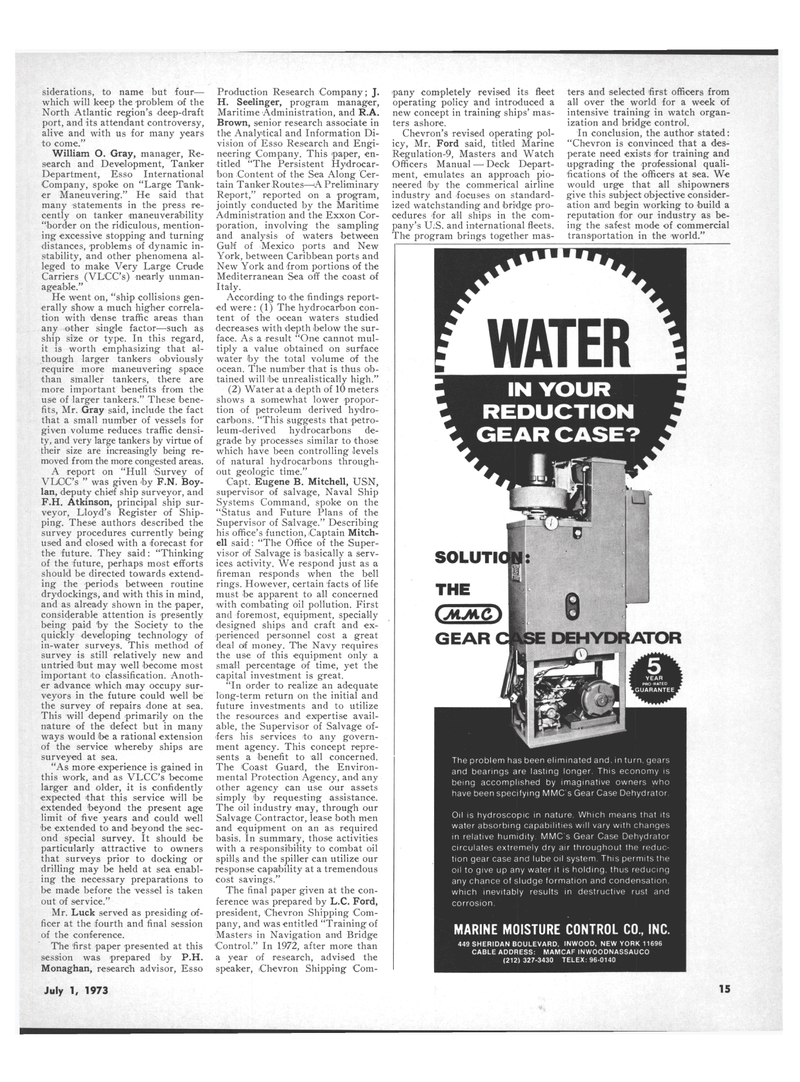
Page 13: of Maritime Reporter Magazine (July 1973)
Read this page in Pdf, Flash or Html5 edition of July 1973 Maritime Reporter Magazine
siderations, to name but four— which will keep the problem of the
North Atlantic region's deep-draft port, and its attendant controversy, alive and with us for many years to come."
William O. Gray, manager, Re- search and Development, Tanker
Department, Esso International
Company, spoke on "Large Tank- er Maneuvering." He said that many statements in the press re- cently on tanker maneuverability "border on the ridiculous, mention- ing excessive stopping and turning distances, problems of dynamic in- stability, and other phenomena al- leged to make Very Large Crude
Carriers (VLCC's) nearly unman- ageable."
He went on, "ship collisions gen- erally show a much higher correla- tion with dense traffic areas than any other single factor—such as ship size or type. In this regard, it is worth emphasizing that al- though larger tankers obviously require more maneuvering space than smaller tankers, there are more important benefits from the use of larger tankers." These bene- fits, Mr. Gray said, include the fact that a small number of vessels for given volume reduces traffic densi- ty, and very large tankers by virtue of their size are increasingly being re- moved from the more congested areas.
A report on "Hull 'Survey of
VLOC's " was given by F.N. Boy-
Ian, deputy chief ship surveyor, and
F.H. Atkinson, principal ship sur- veyor, Lloyd's Register of Ship- ping. These authors described the survey procedures currently being used and closed with a forecast for the future. They said: "Thinking of the future, perhaps most efforts should be directed towards extend- ing the periods between routine drydockings, and with this in mind, and as already shown in the paper, considerable attention is presently being paid by the Society to the quickly developing technology of in-water surveys. This method of survey is still relatively new and untried but may well become most important to classification. Anoth- er advance which may occupy sur- veyors in the future could well be the survey Of repairs done at sea.
This will depend primarily on the nature of the defect but in many ways would be a rational extension of the service whereby ships are surveyed at sea. "As more experience is gained in this work, and as VLCC's become larger and older, it is confidently expected that this service will be extended beyond the present age limit of five years and could well be extended to and beyond the sec- ond special survey. It should be particularly attractive to owners that surveys prior to docking or drilling may be held at sea enabl- ing the necessary preparations to be made before the vessel is taken out of service."
Mr. Luck served as presiding of- ficer at the fourth and final session of the conference.
The first paper presented at this session was prepared by P.H.
Monaghan, research advisor, Esso
Production Research Company; J.
H. Seelinger, program manager,
Maritime Administration, and R.A.

 12
12

 14
14
